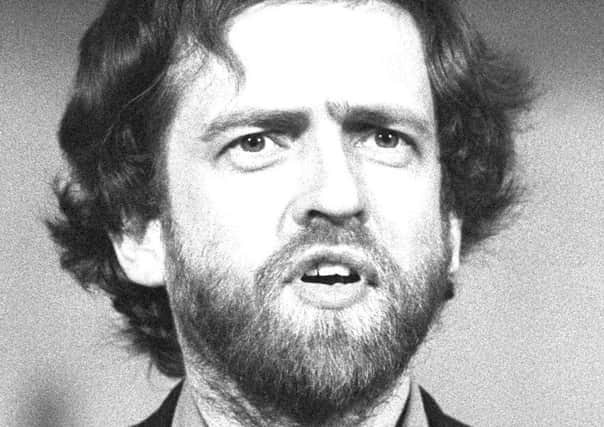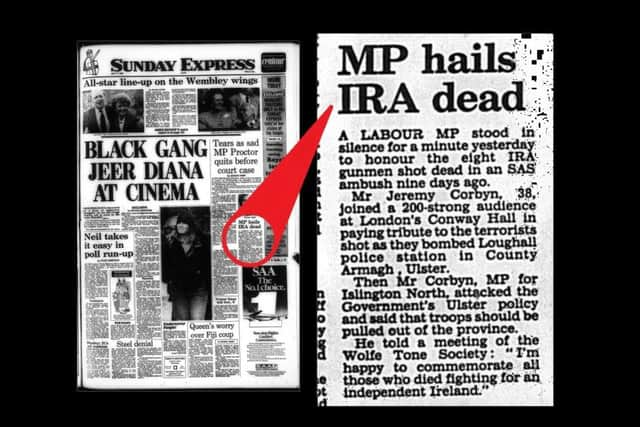Night Jeremy Corbyn stood in honour of dead IRA terrorists


The new Labour leader also moved to deflect security fears after inviting republican figures to the Commons in the 1980s by pointing out that the blueprints of the building were already available to them.
Following fresh revelations of Mr Corbyn’s connections with pre-ceasefire republicans in the Sunday Telegraph, the News Letter is able to shed new light on two of the existing controversies about his past actions, including one of his earliest recorded clashes with unionism.
Advertisement
Hide AdAdvertisement
Hide AdWhile he has condemned violence, when asked recently to condemn the actions of the IRA he was reluctant to do so – see this audio clip of an interview on the Nolan Show.


One frequently reported claim from his past is that Mr Corbyn stood in honour of eight members of an IRA gang who had been shot dead by the SAS in Loughgall in 1987 (as well as a civilian, who was wrongly targeted by the SAS).
The News Letter has searched for the original source of this claim, and found only a short reference to it in a publication called Politics Today, listed by Google Books as belonging to Conservative Central Office, 1988.
Politics Today in turn says that the story stems from an edition of the Sunday Express on May 17, 1987.
Advertisement
Hide AdAdvertisement
Hide AdThe British Library has provided the News Letter with a copy of the paper’s front page from that date.
It reads (under the headline ‘MP hails IRA dead’): “Mr Jeremy Corbyn joined a 200-strong audience at London’s Conway Hall in paying tribute to the terrorists.
“Mr Corbyn, MP for Islington North, attacked the government’s Ulster policy and said troops should be pulled out of the Province.
“He told the meeting of the Wolfe Tone Society: ‘I’m happy to commemorate all those who died fighting for an independent Ireland’.”
Advertisement
Hide AdAdvertisement
Hide AdAnother of the criticisms often made of Mr Corbyn is that in 1984, the year after he had been elected, he was responsible for bringing republican figures into the House of Commons for a meeting.
It happened not long after the IRA had attempted to wipe out the upper echelons of the Government in the Brighton bombing.
By trawling through the archives of Hansard (the official record of Commons debates), the News Letter can show that the decision stirred the ire of a string of unionists at the time – including the Rev Ian Paisley.
Rev Paisley told the House on December 20, 1984: “Every right-thinking person in Northern Ireland utterly abhorred the action taken by the honourable member for Islington North when he brought into the House Linda Quigley, who has been convicted as a member of the IRA.
Advertisement
Hide AdAdvertisement
Hide Ad“She said that she supported the IRA’s view that the British Government were a legitimate target. Therefore, she supported the bombing at Brighton, when an attempt was made to murder the Government.
“It must be utterly abhorrent to all people that an honourable member brought such a person into the House.”
The then-MP for North Antrim went on to say that “Sinn Fein should be proscribed, no matter how many votes it receives”.
Mr Corbyn rose to speak, but the UUP’s Ken Maginnis refused to yield to him.
Advertisement
Hide AdAdvertisement
Hide Ad“I note that his pen portrait in the parliamentary year book states that he likes animals,” said Mr Maginnis.
“I am not one lightly or irresponsibly to use the analogy that I am about to offer to the House, but the IRA members whom the honourable gentleman brought into the House are animals in the worst possible sense of the word.”
William McCrea chipped in to add: “They are vermin.”
Mr Corbyn replied: “Is the honourable gentleman seriously suggesting that those who come into the House as visitors should in some sense be restricted?
“Is he suggesting further that there should be controls on those who come through the doors of the House? Is he saying that members of this place do not have a right to talk to people from Northern Ireland, or anywhere in Britain, about conditions in prisons and their particular political views?”
Advertisement
Hide AdAdvertisement
Hide AdMr Maginnis stated that Mr Corbyn had brought to the House Gerry Adams (then an abstentionist MP), as well as Linda Quigley and a man named in the Hansard record simply as “McLaughlin”.
This is in fact a reference to Gerard MacLochlainn, an ex-republican convict who was until recently a Sinn Fein Londonderry councillor.
Mr Maginnis said that republicans guests to the Commons would have been able to “see everything that might be useful to a terrorist coming into the House with the intention of killing an honourable member or honourable members”.
Mr Corbyn replied: “The honourable gentleman seems to be going into a rather lengthy flight of fantasy.
Advertisement
Hide AdAdvertisement
Hide Ad“Does he agree that this building is a public place, that it is owned by the public and paid for by the public?
“Does he agree further that any member of the public is entitled to go through St Stephen’s entrance and to enter the Palace after passing through the screening process?
“If anyone wanted to obtain a plan of this building, he would be able to buy a history book in any bookshop in this country, or anywhere in the world, which would show him the layout.
“I believe that the honourable gentleman is trying to stir up some non-story and non-issue as a way of avoiding the real causes of the problems in Northern Ireland and the real and serious violations of justice in Northern Ireland, of which apparently he approves.”
Advertisement
Hide AdAdvertisement
Hide AdAs the debate moved on, Peter Robinson, then the MP for East Belfast, began to speak about the ongoing violence in the Province.
He referred to an MP who had felt “hurt by the suggestion that there should be a military solution” to the Troubles.
He added that a military solution “is exactly the proposition that I shall put forward”.
At one point Mr Corbyn appeared to want to speak.
Mr Robinson said: “Does the honorary member for Islington, North (Mr Corbyn), who is babbling incoherently from a sedentary position, wish to intervene?”
Advertisement
Hide AdAdvertisement
Hide AdMr Corbyn did not, and made no more contributions to the debate.
LOUGHGALL:
The Loughgall ambush on May 8, 1987, was the single biggest loss of life for the IRA.
According to the book Lost Lives, the unit from the East Tyrone Brigade had hijacked a digger, which was loaded with a 200-pound bomb.
The digger and a Toyota van then smashed through the part-time station’s gates.
Advertisement
Hide AdAdvertisement
Hide AdThe authorities had foreknowledge of their plan, however, and lay in wait for the attack.
Three RUC officers volunteered to remain inside the station during the ambush, while some soldiers also donned police uniforms.
Although they were “heavily armed” says the book, the IRA team was outnumbered and were killed.